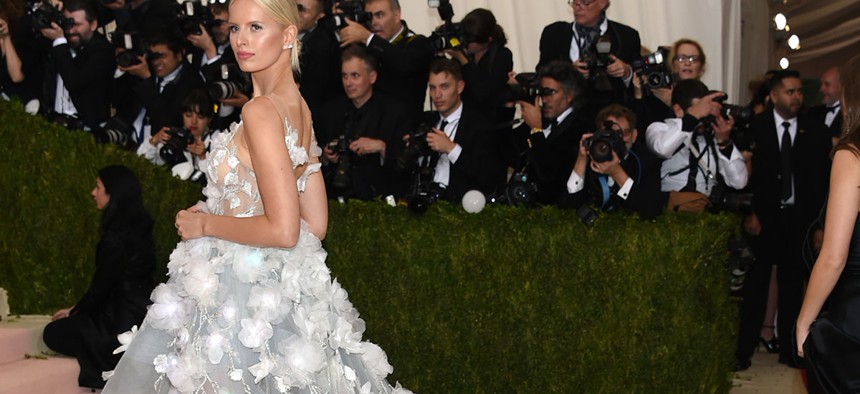Fashion Industry Tells Feds: We Need Better Cybersecurity for Internet-Connected Clothes

Karolina Kurkova arrives at The Metropolitan Museum of Art Costume Institute Benefit Gala with a 'cognitive' dress that had 150 LED lights which changed color when fed data from IBM's Watson. Evan Agostini/Invision/AP
The fashion industry is also urging Washington not to hinder creativity.
The fashion industry is urging Washington not to hinder creativity when the government formulates policies surrounding the internet of things, as everyone from Met Gala celebrity guests to U.S soldiers slips on wired garments.
During February's New York Fashion Week, designer Nayana Malhotra wrapped models in pieces that served as projector screens -- linked to consumer-grade EEG devices. A nearby computer was programmed to detect certain brainwave patterns, then visualize that data with animated GIFs that expressed corresponding emotions. Depending on the model's mood, these GIFs would change and morph as she walked down the runway.
Now, Kenya N. Wiley, founder of the D.C.-based Fashion Innovation Alliance, is asking the Commerce Department to consider the $260 billion digital economy, when crafting any new federal regulations for networked-clothing and other internet of things gear.
The alliance “values the privacy of the consumers using fashion tech products and services, and we recommend that any new policies governing IoT create an environment that supports and advances the ever-growing fashion tech industry without limiting innovation,” she said in a June 2 letter to Lawrence E. Strickling, assistant commerce secretary for communications and information.
Commerce on April 6 had requested the public weigh in on the benefits, challenges and potential roles for the government in advancing ubiquitous interconnectivity, known as the internet of things.
The alliance, whose supporters include the Brooklyn Fashion + Design Accelerator at Pratt Institute, recommended there be a research and development hub for fashion tech in the internet of things, patterned after the Pentagon-funded Revolutionary Fibers and Textiles Manufacturing Innovation Hub.
The military-backed hub, a public-private partnership, launched in April to unite the likes of MIT, Warwick Mills and New Balance in creating electronic systems, flexible enough to be worn, that can see, hear, sense heart rate, adjust temperature and more.
A similar learning program for fashion wearables would emphasize science, technology, engineering, art and design, and math, or "STEAM," training, Wiley said.
For the apparel industry and other sectors to produce more sensor-studded products, there must be more spectrum available for W-Fi, she said.
"Governments will need to" free up unlicensed spectrum for smart garments and personalized mobile apps to use, because Wi-Fi networks already are becoming congested, Wiley said.
"Many fashion tech entrepreneurs and organizations have designed and launched smart apparel and accessories to not only help push humanity forward, but also to help make consumers’ lives more efficient, enjoyable and overall more productive," she added.
That said, the alliance also values confidentiality and advises that cybersecurity and privacy play key roles in internet of things policy. In fact, intellectual property protection, privacy and cybersecurity should "be the largest focus of the IoT innovation center," a program recommended by Wiley that would function similar to the U.S. Patent and Trademark Office’s programs.
Meanwhile, the software industry wants a more hands-off approach from Washington in the internet of things, also for fear of stifling invention. On Thursday, the Software & Information Industry Association sent a letter to Strickling at Commerce, but argued that "industry best practices and self-regulatory codes of conduct provide more flexibility to evolve and adapt over time."
NEXT STORY: DHS advisory council report could help NPPD






